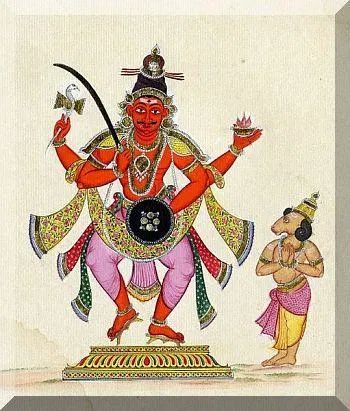
1.1. Virabhadra , the auspicious hero, raging like flaming fire, is Shiva‘s ferocious instrument for destruction of ignorance, ritualism and dogma. Virabhadra, the Great Warrior, is the sublimation of Shiva’s impatience and anger; the embodiment of his resolute might; and is therefore regarded as an aspect of Shiva in blazing mood, burning down delusion and falsehood (samhara – murti).
1.2. It is said; Shiva represents pure-consciousness (jnana shakthi); Devi is the creative energy, the thought within his consciousness, the will to intend an act (itccha shakthi); and Virabhadra is the power of action (kriya-shakthi) the determined might to transform that will into an act. Virabhadra, the action-hero, personifies implicit faith, absolute devotion and reverence as also the ruthless efficiency in carrying out the command of his creator.
1.3. Virabhadra also symbolizes the sharp incisive power of discrimination, potent in each of us, to sever attachments to conceited values, misplaced faith and the routines that we all run through thoughtlessly. He points out to our adulation of that which should not be esteemed; and to our neglect of that which ought to be valued. Virabhadra’s message is to open our heart, to embrace everything that life has given us, without fear or prejudice. Virabhadra destroys in order to save.

*
Daksha – Shiva – Uma
2.1. The origin and the relevance of Virabhadra have to be appreciated in the context of the running feud between Daksha and Shiva spread over many eons, manvantara. The two mighty personages represent two different realities, two divergent faiths, two separate streams of understanding and two opposed world orders.
2.2. Daksha meaning ‘able, competent, skilled ‘in performing rituals, is rooted in the propriety and the relevance of elaborate rituals; and in their techniques as prescribed in the scriptures. He is also a great believer in the organized hierarchy of gods and the proper order of apportioning the oblation among various levels of gods. He is one of the Prajapatis and is sometimes regarded as their chief. He is charged with the responsibility of ensuring perpetuation of life on earth, as also the richness and dignity in life. He is a very prominent person of the established order; and, in fact, is at its very core. Daksha holding the office of Prajapathi was a lawgiver who formulated rules for conduct of behaviour in the society and norms for the orderly working of the society along the well respected traditional lines. The world order as envisaged by Daksha defined the precise role and conduct not merely of humans but of gods as well. He expected from all, reverence to his self and obedience to his law. He would not tolerate subversive bunch of renegades who had scant regard for the social dignity and decorum. Daksha therefore represents the matter-of-fact logical mode of thinking, the way in which most of us would like to lead our lives.
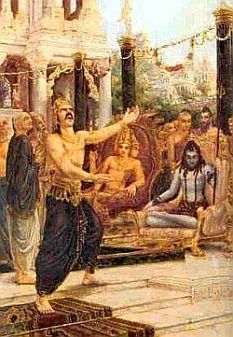
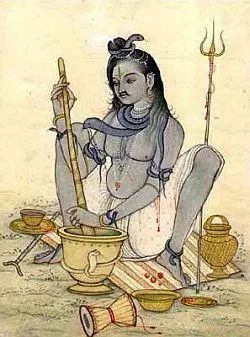
2.3. Shiva, in contrast, was beyond the pale of normal society; and stood for everything that Daksha dreaded. Shiva was a Vratya, and the most distinguished among them, Ekavratya, an unorthodox hermit, who lived by his own rules, not always acceptable to traditional society. He refused to conform to the ways of the world.
3.1. Vratyas were a community of dissenters, social rebels and ascetics living under a set of strange religious vows (Vrata). They totally rejected the Vedic rites and rituals. Vratyas followed their own cult-rules and practices; and did not care either for the rituals or for initiations (adhikshitah); and not at all for celibacy (Na hi brahmacharyam charanthi).They did not engage themselves in agriculture (Na krshim) or in trade (Na vanijyam).They behaved as if they were possessed (gandharva grithaha) or drunk or just mad. They roamed about the countryside and lived among the warriors, herdsmen and farmers. They were worshippers of Rudra, Isana or Mahadeva; and yet were regarded irreligious. In the words of Shri DSamapth, they were the ‘freethinkers who gave a very time and space based approach to the issues; and, were the initial social scientists with rationality as the anchor’.
3.2. Shiva, Rudra the wild one, like a true Vratya, wandered among cremation grounds with a rowdy bunch of renegades consuming intoxicants forbidden in polite society and slept amidst the warmth of burning funeral pyres. He sang and danced whenever and wherever he wanted to with little heed to decorum and protocol. Shiva refused to indulge in any social rule having pretentions of respect. He had no home, no possessions, no family, no vocation; he was a drifter, ritually impure, unsuitable for married life.
4.1. Uma was the daughter of Himavat (Uma Haimavathi) by Menaka or Mena [In this version she is not related to Daksha]; she was desperately in love with Shiva but had a hard time persuading him to marry her. Shiva narrated all his disqualifications that failed to make him a dependable householder. Despite that, Uma followed Shiva wherever he went, over hills, across desolate plains and dense forests and through cremation grounds.

Shiva at first ignored Uma. He barely acknowledged her. Uma finally told her reluctant lover, “It is for the good of both of us.You are incomplete without me and I am incomplete without you. I do not ask for anything, but you. I accept you for what you are, not deterred by what you do not have…I would like to observe with you”. Shiva could no longer be without his loving consort.


5.1. Daksha Prajapathi’s intense dislike of Shiva was because the latter was a vagrant, a tramp who had neither commitments nor sense of values in life. Daksha called Shiva – a Kapalin having neither father nor mother, impure , incorrigible and proud abolisher of rites and demolisher of barriers; and, one who roams about in dreadful cemeteries, attended by hosts of ghosts and sprites, like a madman, naked, with disheveled hair, wearing a garland of skulls and ornaments of bones of the dead, pretending to be Siva (auspicious), but in reality is a- Siva (inauspicious), insane, leader of the insane Bhutas (spirits), the wicked hearted whose nature is essentially darkness.’ Let this Bhava (Siva), lowest of the gods, never, at the worship of the gods, receive any portion along with the gods Indra, Upendra (Vishnu), and others’. Thus, Daksha had every reason to dislike Shiva.

5.2. Uma’s perception of Shiva is of a different kind. It is non-judgmental absolute faith and intense love. There are no words to describe it otherwise. It obviously is unwise. But, that foolish wisdom is a precious gift of grace received in humility of mind and simplicity of heart; an un-bounded loving energy that transforms the world more effectively than the rhetoric. But, that rarely happens.
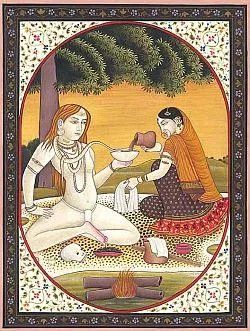

6.1. The Daksha – Shiva conflict is more along the traditional lines, It is between establishment and anti-establishment. It occurs in every generation and all the time. It is the conflict between normal learning and intuitional understanding; between the conventional point of view and the transcendental experience; and between the man of the world and the one who has cast off all concerns and obligations.
6.2. The Indian traditions, for some reason, have always regarded content-less intuitional understanding and recognition of ‘what Is’ as being far superior to belief systems or a schools of thought. Our ancients always asserted that the immediate experience (sakshat aparoksha) which liberates is truly superior to the intellectual knowledge of scriptures, rites and rituals. They explained it as the sort of experience that leads to the true understanding of the problems of being and becoming; that which aids to cross over all sorrows (shokasya param trayathi); and to realize one’s true identity. It is beyond the understanding of the intellect; it is experience (we shall return to this theme a little later).
6.3. The Daksha –Shiva conflict enacts the theme of limited formal learning giving place to expansive intuitional understanding. This theme manifests in life, in all ages, in various forms. The ego fears for its death, so it refuses to surrender to the heart. But, it eventually does give in. The old sage Parashara wryly remarks “in every age Daksha and the rest are born and are again destroyed.”
6.4. The emergence of Virabhadra as Shiva’s instrument for destruction of Daksha’s small ’ego’ and for awakening of true understanding in him occurs when Daksha was born as the son of Prachetas and Marisha; and was designated as Prajapathi in age of Vaivasvata Manu.
Daksha yajna
7.1. The performance of the magnificent and most elaborate Brahaspathi – savana – yajna by Daksha Prajapathi must have been a highly significant event in the very ancient past. The Daksha story became a ground for fertile epic imagination. Countless versions of the event were described elaborately in various Puranas, epics and folk legends; each version, of course, bending the event to champion its own pet theme.
By all accounts, ‘Daksha’s sacrifice’ shook the old world and brought in a new world order. Shorn of prejudices and rhetoric, the legend indicates that Rudra-Shiva an unorthodox god stormed his way into the world of established order, secured there a prominent undisputed status among all gods and claimed a fair share of esteem and oblations that were due to him. It also amply demonstrates the futility and irrelevance of mere scriptural learning, rituals and sacrifices; and upholds the way of right-understanding as the means to liberation from all sorrows.
7.2. But the germ of the story seems to be in the Taittiriya Samhita(2.6.8) , where the gods, excluded Rudra from a sacrifice; and he pierced the sacrifice with an arrow; thereafter a ‘well offered yajna (svista)’ was submitted to Rudra. Gopatha Brahmana too carries a similar story where Prajapathi deprived Rudra of his share in the Yajna; then Rudra pierced the Yajna (prasitra) and gained his share. In these brief references, there is no mention of Daksha by name; and Rudra gains his share of the Yajna by force. There, of course, is no Virabhadra.

7.3. There is another reference to Shiva and Daksha in Ramayana. The King Janaka describes the great bow Shiva Dhanus as the one wielded by Shiva when he threatened to destroy Daksha’s Yajna because Devas had not offered Shiva a portion of the oblations. In this version of the legend also there is no mention of Rudra commissioning Virabhadra, or anyone else, to destroy the sacrifice or put the gods to flight. He is simply said to wound the gods with his bow.
8.1. All these references indicate that Shiva ( it is not clear if he was the same as the Rudra of the Rig Veda) who perhaps was at the periphery was determined to break into the world of Vedic rituals , to be recognized as one of the major gods and to secure a fair portion of the Yajna because of the esteem associated with it.
8.2. The later epic –poets strung together these references; and spun amazingly elaborate and divergent tales around Shiva – Daksha Prajapathi conflict. The various Puranas were structured, basically, in two levels. One, Daksha and Shiva were projected as two opposite poles in the society; Daksha representing the establishment and Shiva the anti – establishment and everything that Daksha hated.
Uma the Devi was the gracious link of love that connected the two opposing worlds.
The other was the determination of the Devas to continue to keep Shiva out of the Vedic fold and to refuse him recognition within its orthodox framework by denying him a share of the Yajna; and Shiva’s repeated, determined and forceful efforts to secure the esteem which he thought was due to him. He does eventually succeed not merely in gaining acceptance but also in becoming the premier god in the Vedic pantheon revered with fair share of the Yajna oblations. Along with that, the Pashupathas stood to gain some recognition within the Vedic fold, though it was conceded very reluctantly.
8.3. In addition, two other minor themes run through the narrations: One is the element of Shiva –Vishnu rivalry; and the other is the efforts of the Shaktha cult to use the events at Daksha-yajna in order to relate the origins of its Shakthi peethas and to base its legends.
8.4. There is however a dichotomy in these narrations; and it is not adequately explained. The followers of Shiva, mainly the Pashupathas, did not seem to have faith or respect for the Vedic rituals and their efficacy. Yet, they fight very hard, even by violence, to secure their leader a fair share in the Yajna and to see him established in the hierarchy of the Devas. And, eventually they agreed to become a part of the very Yajna which they set out to destroy.
8.5. In any case, several Puranas together have woven a very complicated ( at times confusing ) maze of stories involving assumed traditional proprieties, their alleged breach, disputed claims, divided loyalties and prejudices for and against Shiva or Vishnu; and, an undecided stand on the efficacy of Vedic rituals.
Narrations in Vayu Purana
9.1. Of the several versions of the Daksha Yajna, the narrations in Vayu Purana, perhaps the oldest of the extant puranas and in Mahabharata are restrained and comparatively brief. They describe, in substance, the waste of food and drinks stored for the Yajna and the burning of the Yajna. Here, Devi is presented, without a preamble, as Parvathi or Uma daughter of Himavat (Uma Haimavathi) by Menaka or Mena . In this version she is not related to Daksha; she does not also visit the Yajna; and she does not die (out of grief at the insult directed at her husband).There are no references in these versions to the previous conflicts or the enmity that existed between Daksha and Shiva. Here, Shiva’s anger is directed not so much against Daksha as against the unfair arrangement devised by the Devas to deprive him of a share of the Yajna. He wills Yajna to be disrupted; but he does not command Virabhadra to kill Daksha. Shiva left to himself, perhaps, would have accepted the position as it were but for Devi who felt slighted and did not want to see her husband belittled by other gods.
9.2. Here, Uma is terribly unhappy that her husband is not invited to a great Yajna where all other gods participate joyously. And she anxiously enquirers why he does not proceed to the Yajna; what holds him back? Mahadeva replied ‘This is the contrivance that in all sacrifices no portion should be assigned to me’. Devi is filled with ‘deep sorrow and trembling’ and is hardly able to restrain as her husband ‘of unsurpassed splendor, glory and power’ is excluded from share of oblations. Then, after prodding from Parvathi, Shiva says “O queen of the gods, behold whom I shall create for the purpose of claiming my share of the oblation in the yajna”.
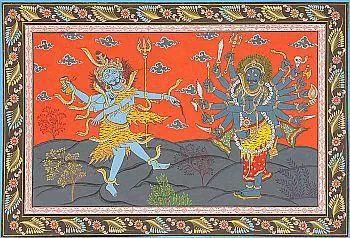
10.1. He then creates Virabhadra from his mouth . In these versions; there is no beheading of either the Yajna who assumed the form of a deer or of Daksha. There is also no mention of beating up and mutilating various gods and sages assembled at the Yajna. Daksha at the end realizes his folly and submits to Shiva who pardons and grants him salvation. Yajna is concluded successfully. All ends well.
Lets us briefly go over the narrations as provided in Vayu Purana and Mahabharata- Book 12: Santi Parva: Mokshadharma Parva.[ The following is extracted from Prof.Wilson’s translation of Vayu-Purana ] We can later have a brief look at the variations of the legend as depicted in other Puranas.
Virabhadra
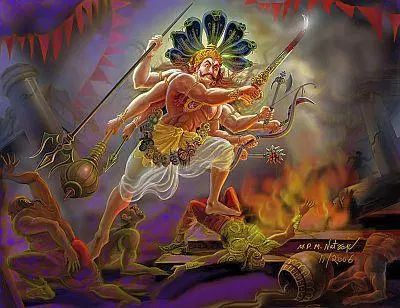
10.2. “ Having spoken thus to his beloved the mighty Mahadeva created out of his mouth a most magnificent and frightening being glowing like the fire of fate (kaala-agni); a divine being with thousand heads , thousand eyes , thousand feet , thousand arms , wielding a thousand clubs, thousand shafts ; holding the shankha , chakra, mace, bearing a blazing bow and battle axe; fierce and terrible shining with dreadful splendour; decorated with crescent moon; clothed in tiger skin; dripping with blood; having a capacious stomach and a vast mouth armed with sharp protruding formidable tusks; his tongue was lightening; his hands brandished thunderbolt; flames streamed from his hair; a necklace of pearls wound around his neck; a garland of flames descended from his breast; radiant with luster he glowed brilliantly like the final-fire of destruction that consumes all existence.

Four tremendous tusks projected from his wide mouth extending from ear to ear; he was of vast bulk, vast strength a mighty war god and destroyer of universe and like a vast fig-tree in spread, shining like a hundred moons at once; fierce as the fire of love; sharp white teeth and mighty fierceness , vigour, activity and courage; glowing like a thousand fiery suns at the end of the world; like a thousand undimmed moons; in bulk like Himadri , Kailasa and Meru or Mandara with all its gleaming herbs ; bright as the sun at the end of ages; of irresistible power; beautiful aspects; irascible with lowered eyes and a countenance of burning sun; clothed in the hide of elephant and lion and girdle of snakes; wearing a turban on the head, moon in his brows.
10.3. Sometimes savage; sometimes benign; having a chaplet of flowers on his head; anointed with various fragrant perfumes adorned with variety of ornaments and many designs of jewels; wearing a heavy garland of karnikara flowers and rolling his eyes in rage.
cakra nālīkanārāca istomaraiḥ khaḍga mudgaraiḥ / vatsa dantaistathā bhallaiḥ karṇikāraiśca śobhanaiḥ // RKV_48.55 /
evaṃ na śakyate hantuṃ dānavo vividhāyudhaiḥ / tadā jvālā-karālāś-ca khaḍga-nārācatomarāḥ // RKV_48.56 //
Sometimes he danced wildly , sometimes he sang out aloud, sometimes he wept out uncontrollably; sometimes he spoke gently sweetly , meditated intensely; he was endowed with faculties of wisdom, dispassion , power, penance, truth, endurance , fortitude and self-knowledge.
10.4. Virabhadra of Rudra-manohara –rupa, of terrifying and the same time heart-warming form, born of Shiva’s potent mouth (Va.p.30.122) was thus like Purusha of Rig Veda of immense strength and splendour, a great being with a huge body the size of any mountain, ablaze and adorned with crescent moon.
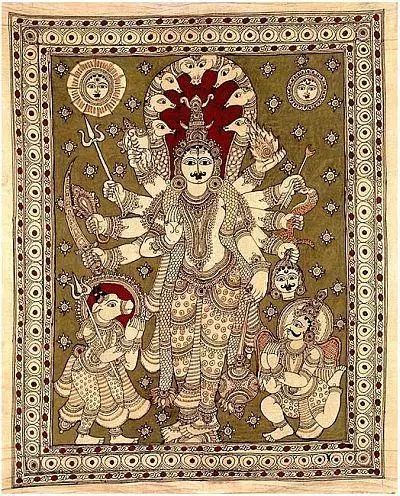
10.5. His monstrous exterior disguised his true nature of vibrancy – full of wisdom, detachment, sovereignty, asceticism, truth, patientince, fortitude, lordship and self knowledge (Va.p.30.125-136).He greatly resembled Shiva whose emanation he was.
11.1. The mighty Virabhadra knelt down upon the ground in respect and raising his hands on to his head in reverence addressed Mahadeva “Sovereign of gods, Command me! What is it you desire me to do?” Mahadeva charged Virabhadra to “destroy the yajna of Daksha”
11.2. Then the powerful Virabhadra having heard of the pleasure of his Lord bowed down his head to the feet of his Master and jumping out like a lion loosed from shackles he rushed to despoil the Yajna of Daksha. The wrath of Devi took the form of the fearful Rudrakali. She accompanied Virabhadra with all her train to witness the destruction.
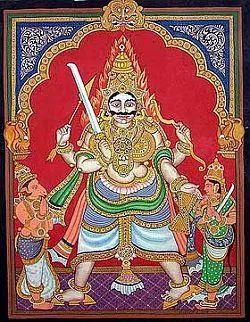

2.1. Virabhadra then created from the pores of his skin powerful demigods the Ganas the attenders on Rudra, of equal valour and strength, who poured out in hundreds and thousands. Then, a loud and confused clamour filled the air and heavens with dread. The mountains tottered , the earth shook, the winds roared wildly, the depths of the oceans were disturbed; the fires lost their radiance and the sun grew pale; the panels of the firmaments shone not; neither did the stars give light; Rishis ceased their hymns; and gods and demons alike were muted; thick darkness enveloped the sky like blankets.
12.2. Virabhadra and his Ganas set out in chariots drawn by ten thousand lions. Among his bodyguards were Sixty-four groups of Yoginis, Shakhini, Dakhini, along with Bhutas, Pramathas (churn spirits) guhyaka (guardian of hidden treasures), Bhiravas, kshetrapalas and other types of spirits and fiends.
13.1. In the meantime, Dadhichi, one of the sages assembled at the Yajna is distressed when he learns that Rudra had not been invited. He queries Daksha, “Why do you not offer homage to the god who is the lord of life?” and remarks “The man who worships what ought not to be worshipped or pays not reverence where reverence is due , is guilty, most assuredly , of heinous sin”. To which, Daksha laughs and replies “I have already many Rudras present, armed with tridents, wearing braided hair, and existing in eleven forms. I recognize no other Mahadeva”. Dadhichi offended by Daksha’s reply walks out of the Yajna warning it would not be completed.
Destruction of the Yajna
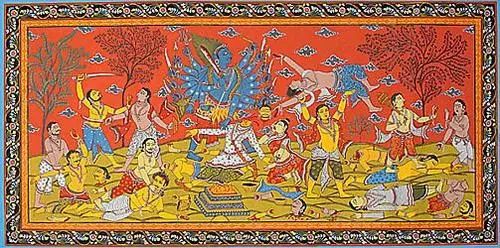
14.1. Then the gloom emerged fearful and numerous hideous forms, shouting aloud frightening battle cries instantly broke and overturned the sacrificial altar and danced amidst the oblations. Running wildly hither and thither like hurricanes they tossed about the implements and vessels of the yajna. The piles of the wood and the beverages stocked for the Devas like little mountains; the rivers of milk; the banks of curds and butter; the sands of honey, buttermilk and sugar; the mounds of condiments and spices of every flavor; the undulating knolls of flesh and other vandals ; the mounds of celestial liquor , pastes and confections which had been prepared; these the spirits of wrath devoured with glee . Then falling upon the assembled Devas the vast and furious Rudras mocked and insulted the nymphs and quickly put an end to the Yajna.
14.2. His sacrifice being destroyed, Daksha overcome with terror and utterly broken in spirit fell upon the ground. The multitude of the assembled Devas in disarray cried out helplessly “O Rudras have pity on us thy servants; o lord dismiss thy anger”. They all pleaded “Declare who you are. Which Deva are you”.
Virabhadra shouted back “I am not a Deva or an Aditya; nor I come here for enjoyment; nor am I curious to see the various Devas. Know you all that I am here to destroy the despicable Yajna of Daksha; I am Virabhadra springing forth from the wrath of Rudra; Bhadra kali who sprang from the anger of Devi is sent here with her multitudes of spirits to destroy the yajna. Take refuge you all Devas and Rishis at the feet of Rudra the lord of Uma; f or better is the anger of Rudra than the blessing of the Devas (ymram Icrodho ‘pi devasya vara-danam na chanyatah)”.
14.3. Suppressing his vital airs – prana and apana- and taking a position of meditation, Daksha tried fixing his thoughts .Then god of gods, Mahadeva appeared out of the sacrificial altar resplendent as thousand suns , smiled upon him and said “Daksha your Yajna has been destroyed through the sacred knowledge. I am well pleased with you. What shall I do for you?”

14.4. Then Daksha frightened, distressed and alarmed fell on his four , his eyes suffused with tears and hands raised over his brows in reverence and submission pleaded with the mighty Lord ” If you are pleased with me , have mercy on me , confer me this boon, this is the blessing I beseech of you, all these provisions that have been prepared with much effort and time , which now have been eaten , drunken and destroyed by hosts may not have been prepared in vain”. “So be it” said the merciful lord. Whereupon the relieved Daksha fell upon the feet of Mahadeva and burst into hymns, celebrating one thousand and eight names of the lord.”

…and thereafter
15.1. The story, though it highlights vandalism and destruction, it is, in essence, the glorification of Shiva as the Supreme Lord. He destroyed the sacrifice from which the Devas had excluded him; and having destroyed it he made it the whole again and won his share. After the destruction of the Yajna the Devas lost their creative power. It is said; the Devas did not fully understand Mahadeva the great god, ferocious and kind at the same time; ruthless at one time, kind and benevolent at another; a demon and an ascetic. That is the pristine nature of Shiva.
15.2. As the Devas praised Shiva they all Pashus were relieved of their bonds and Shiva became their Lord Pashupathi. He gave back to each god his of creative power and understanding (Varaha Purana 21.78-82;33,25-28; and Mbh .10.18.22-23) . The gods recognized Shiva as the lord of the knowledge that liberates – Pashupathi.
15.1. In substance, the event was primarily a solemn Vedic event to which all important persons of that age were invited. Daksha who performed the yajna appeared a follower of Vishnu; and obviously there were many others who were not. A participant, perhaps a follower of the Pashpatha School which dominated the mountain areas, points out the lapse in not inviting Shiva and suggests that could be rectified by more equitable representation. Daksha annoyed at that, spurns the suggestion. But eventually Daksha learns his lesson the hard way; and submits to the strength of the Pahupathas .It was the triumph of Pashpatha; but then thereafter they seemed to soften their stern stand.
15.2. In one of the Versions of the event, Nandisvara, an ardent follower of Mahadeva very strongly condemns Vedic rituals as also those who believe in it : ” let him, from a desire of vulgar pleasures, practice the round of ceremonies, with an understanding degraded by Vedic prescriptions. Forgetting the nature of soul, with a mind which contemplates other things, let Daksha continue to exist in this world of ceremonial ignorance. Let the enemies of Rudra whose minds are disturbed by the flowery words of the Veda, become deluded! Let those Brahmans, eating all sorts of food, professing knowledge and practicing austerities and ceremonies merely for subsistence, delighting in riches and in corporeal and sensual enjoyments, wander about as beggars! “
15.3. The sage Bhrigu spokesperson of the orthodox who were present at the sacrifice launched a counter attack and cursed the Pashupathas : ‘Let those who practice the rites of Bhava (Mahadeva) having lost their purity, deluded in understanding, wearing matted hair, and ashes and bones, let them undergo the initiation of Shiva, in which spirituous liquor is the deity ”. The Pashupathas that Bhrigu described might be the forerunner of the Naga Sadhus of all weird appearances who throng the Kumbha Mela.

6.1. As if to justify Brighu’s curse, the Pashupathas and various schools of Avadhutas emerged strongly after the Daksha –yajna episode. And, despite their heretical stand they gained acceptance within the Vedic traditions as the essence of the most sublime spiritual wisdom. For instance, the classical texts Avadhuta –Gita, Astavakra -Gita and similar other texts celebrate the glory of one who has no use for social etiquette, not bound by any dharma, never knows any mantra in Vedic meter or any ritual; and having renounced all, he moves about naked, roams the earth freely like a child, like an intoxicated or like one possessed; perceives the Absolute, the All, within himself.
These extreme schools decried scriptural learning: There are no divine scriptures, no imperative religious practices; there are no gods, no classes or races of men, No stages of life, no superior or inferior; there’s nothing but Brahman, the supreme Reality. He is the embodiment of detachment and spiritual wisdom.
[ It is said; Pashupathas should be viewed as distinct from Kapalikas who practice extreme forms of Tantra. The Pashupathas are said to be inspired by wisdom and shun hideous ritual-practices.]
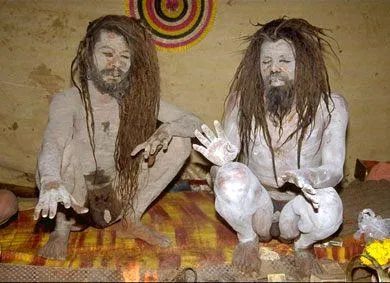
16.2. Shakthas who along with Pashupathas perhaps had strong presence in the mountain regions emerged stronger after the Daksha-yajna. The Daksha-Yajna lore provided them a base for building their legends and temple -chains of Shakthi Pithas .These legends grew rapidly ; and the Pithas associated with Devi’s organs and ornaments soon grew from four to one hundred and eight. The lists of Shakthi Pithas varied from text to text and from region to region. And, eventually, Shakthas too moved into the inner circle of the tradition through various forms of Tantra and Sri Vidya; and laid claim in the Vedic rituals. Later, the cults of Shiva and Devi drew close to each other ; and their merger was symbolized by Shiva-Shakthi, Ardha-narishwara formed by two halves- one each of Shiva and Devi . On a metaphysical level it was the union of the active and passive principles in the universe.
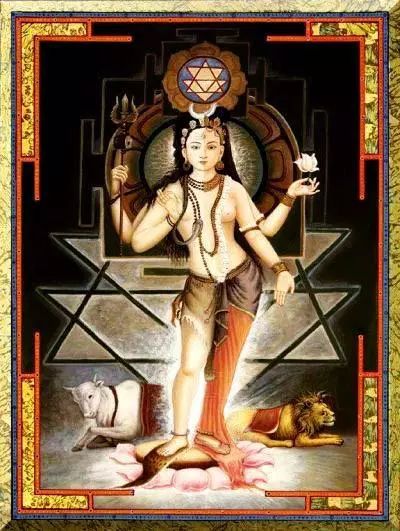
Karaikkal Ammaiyar
17.1. A branch of the Pashupatha cult spread to the South India in its moderate form. It came to be celebrated as the sublime and mysterious Siddha tradition of South. The Siddha is one who has attained flawless identity with reality.
17.2. I cannot resist mentioning here the remarkable Karaikkal Ammaiyar (sixth century) the forerunner of the Siddha tradition in the South and who in the prime of her youth abandoned the respectable life of a traditional dutiful wife and chose to embrace extreme asceticism of unswerving devotion to Shiva in his terrible Bhairava form.
This amazing woman was born as Punitavathi into an affluent trading family in the coastal town of Karaikkal, Tamil Nadu. She had to give-up her home, hearth and husband because of rupture in her domestic life. Punitavathi rejected the social and domestic world of conventions and obligations. She then took shelter in the cremation ground as one of Shiva’s Gana, an adoring ghoulish attendant. Punitavathi beseeched Shiva to divest her of the burden of her flesh asking only that she watch him dance into eternity. It is said; a miracle occurred: In place of the young woman stood an emaciated hag. She even began to look like an emaciated frightening attendant of Bhirava haunting the cremation ground. Known from henceforth as Mother of Karaikkal (Karaikkal Ammaiyar) she came to regard the cremation ground as the truly beautiful place of liberation and the ideal abode to dwell in peace with the Lord of Universe. From then on she wrote poetry in praise of Shiva.
The ground is damp with liquid marrow–
Skeletal ghouls with sunken eyes
jostle and elbow–
looking furtively around them
extinguishing the fires
with gleeful hearts
they eat half-burned corpses–
There, in that menacing forest
holding fire in his hand
dances our beautiful lord.
(Vidya Dehejia, Antal and Her Path of Love: Poems of a Woman Saint from South India, 1990)
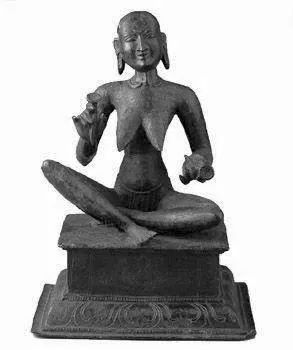
Seated Saint Karaikkal Ammaiyar Chola period, 12th century;Metropolitan Museum of Art, New York
This image portrays her not as a fearsome figure but as a once-beautiful woman who has lost her flesh. Her calm, smiling face expresses her inner peace while she blissfully plays her cymbals and sings to the glory of Shiva.
17.3. Ammaiyar in her poetry asserts that to know Shiva, ones state in life or ones gender is irrelevant; but one should truly transcend the limitations of ordinary human awareness and should give up a life rooted in conventions, attachments and rituals. She does not talk of temples, worship, rituals etc; and she criticizes those who vainly attempt to know Shiva through hallow rituals.
Liberation from cycle of rebirth and to attain the nature of Shiva is the aim of Shaiva-siddantha. Ammaiyar exhorts devotees to meditate in intense devotion on Shiva the ultimate truth and the only means to salvation.
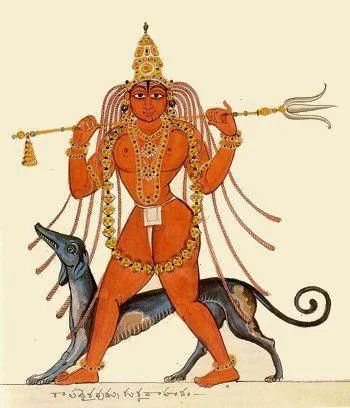
17.4. Through her powerful poetry, Karaikkal Ammaiyar proclaims that the horrific cremation ground is indeed the cosmos; and the terrifying form of Shiva performing his dance of destruction is really the most sublime and blissful expression of the Lord. She makes the terrible look beautiful. Ammiyar asks one to go beyond terror and revulsion associated with the dreadful cremation ground ; to regard it as the theater of Shiva’s dance of life and death ; and as the sacred grove of liberation from this world. It is where one overcomes fear of death and the fear of losing attachments. She explains cremation ground as the state of one’s mind, as the space in ones heart where the ego and ignorance are burnt to ashes over which Shiva dances in delight the dance of destruction. She urges the seeker to revere Shiva as the beautiful embodiment of the rhythm of life, as the destroyer of our illusions, as the conqueror of death, as pure consciousness and the ultimate sovereign of the universe.

17.5. Kariakkal Ammaiyar’s poetry is filled with vivid images of Shiva as the heroic god whose grace rescues his devotees from sorrows of the world. Bones are a central liberation motif in Karaikkal Ammaiyar’s poetry. Shiva adorns himself with a garland of bones he finds in the cremation ground.
Ghouls with flaming mouths and rolling, fiery eyes,
17.6. Karaikkal Ammaiyar’s extreme asceticism (Pashupatha) portrays the state where the seekers strived, in body and spirit, to be Shiva the terrible Bhairava residing in the cremation ground. Ammaiyar’s way of life and her teachings represent the early phase of Tamil Shaiva tradition before it transformed into a temple-based orthodoxy. It is said; because of its extreme views, Karaikkal Ammaiyar’s poetry is not normally sung in Shiva temples today along with the devotional hymns of the Tevaram poets.
Think of our Lord all the time
[For more on Karaikkal Ammiaiyar, please read The Anatomy of Devotion: The Life and Poetry of Karaikkal Ammaiyar by Professor Elaine Craddock; Department of Religion and Philosophy; Southwestern University, TX]

The other Versions of Daksha Yajna legend
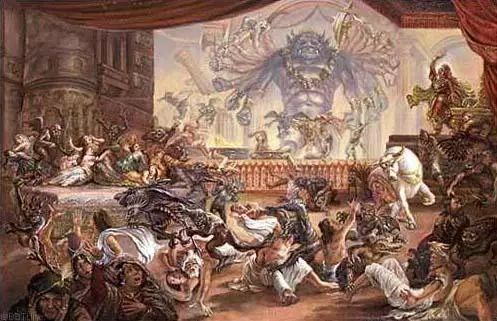
18.1. As mentioned earlier, the legend as narrated in Vayu Purana is simpler and more restrained. The story however gets complicated and more violent in other Puranas. For instance, in Kurma Purana, Sati is described as the daughter of Daksha prajapathi who is unhappy with Shiva his son-in-law because Daksha thought Shiva did not offer him the respect he deserved. And when Sati his daughter visits him next, Daksha abuses Shiva and turns Sati out of his house. Sati in deep sorrow and anguish gives up her life. Shiva on hearing the horrible news curses Daksha. Shiva then did penance and obtained Sati again reborn as Parvathi daughter of Parvatha-raja. She also undertook penance to obtain Shiva as her husband. It is in her next birth that the much talked about Yajna takes place. The Linga, Matsya, Skanda, Padma and Bhagavatha puranas mention of disputes between the daughter and her father in greater detail and say that Sati put an end to herself out of devotion and love to her husband.
It is only in Kasi kanda, a long poem, forming a part of the Skanda Purana that Sati throws herself into fire. This could be an improvement over Vayu purana and other versions.

18.2. The exploits of Virabhadra and his Ganas are more particularly described in the Linga, Skanda and Bhagavata puranas. Here, on hearing of the death of Sati, Shiva enraged produced out his wrath a terrible form of Virabhadra and asked him to destroy Daksha’s Yajna. Bhagavata Purana adds a more picturesque creation of Virabhadra (4.5.3).Shiva pulls out locks of matted hair and strikes against the mountain rocks. However, In Kurma purana it is the Devi who requests Shiva to create Virabhadra. According to Mahabharata, Virabhadra was born out of Shiva’s brow (Mbh.12.274.36-38)
18.3. The destruction and violence are particularly described in these texts. Indra is knocked down and trampled upon; Yama has his shaft broken ; Saraswathi and Maitra have their noses cutoff ; Mitra or Bhaga has his eyes pulled out; Pusan has his teeth thrust down his throat ;Chandra is pummeled; Agni’s hands are cut off ;Bhrigu loses his beard ;the Brahmanas are pelted with stone; Prajapathi is beaten up; and all Devas and semi Devas run through the swords, struck with trident or pierced with arrows.
Harivamsa mentions that the Ganas made a hideous clamour and others furiously shouted, when Yajna began to fly up to heavens in the shape of a deer; and Virabhadra cut of its head which then settled in the heavens as the star Mriga-shira.
Shiva Purana mentions that Virabhadra pulled out Daksha who was hiding behind the altar, cut off his head and threw it into the sacrificial fire pit, the last sacrificial offering (Sp.2.2.37-61).Another version mentions that Virabhadra gave the severed head to Mahakali who played with it. Later, it is said, at Shiva’s instructions the gods put the head of the sacrificial goat on the decapitated body of Daksha. Shiva glanced at the goat head and Daksha came alive, as if waking from a deep sleep.
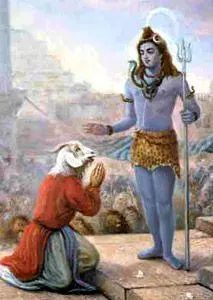
In another version Daksha’s sacrifice was destroyed by Shiva himself; and he danced the dance of death in the evening (Ns.4.234)
18.4. The Vayu Purana does not mention of the conflict between Shiva and Vishnu or the fight of Vishnu with Virabhadra .In the Linga purana , Vishnu’s head is severed and his head is thrown into the sky. The Kurma purana is less irreverent towards Vishnu; it mentions about Vishnu’s conflict with Virabhadra but Brahma intervenes and separates the contestants. The Kasi Kanda of the Skanda Purana describes Vishnu as defeated and at the mercy of Virabhadra .But Virabhadra is directed from heavens not to destroy Vishnu .
According to Hari Vamsa , a fight ensued between Vishnu and Shiva during which Vishnu grasped Shiva’s throat and caused black rings marks (suggesting it was not by poision he consumed after the churning of the ocean).
18.5. In every version of the legend a reconciliation takes place between Daksha and Shiva at the end. Daksha free from malice invites Shiva to preside over the Yajna and sings his praise. But each Purana bends the Daksha Yajna legend to suit its own pet theme and to further its cause.
Virabhadra Iconography

19.1. Virabhadra is described as great warrior and one the trusted generals of Shiva. He is also the protector of sages. The puranas attribute to Virabhadra number of exploits against demons and the benevolent acts performed for protection of the holy ones. As an auspicious god, Virabhadra is worshipped greatly in Karnataka, Andhra and Maharashtra regions where numbers of temples are dedicated to Virabhadra.
19.2. The images of Virabhadra appear in the temples of ninth and tenth centuries sculpted in the deva koshta (niches) figures of gods on the temple walls. In the earlier period they appear as four armed images. And later they expand into eight armed or ten armed images of Virabhadra holding khadga, shula, parashu, dhamaru, bow and arrow etc .
19.3. The cult of Virabhadra – the ferocious and formidable aspect of Shiva- was popular among the warriors of the Vijaynagar period. Virabhadra was the mascot, the war- cry and the inspiration of the armies and fighting forces of Vijaynagar.The Virabhadra temples proliferated in the Vijayanagar region mainly in Karnataka, Andhra and southern parts of Maharashtra.
20.1. The awe-inspiring form of Virabhadra is described in various Puranas narrating the tale of Daksha Yajna. His description narrated in Vayu Purana is highly picturesque (as can be seen from the earlier paragraphs).The Shilpa – texts too provide the iconographic features of Virabhadra. But, these relate to worship-worthy images installed in temples. Let’s briefly see a couple of such details.

20.2. The Silpasangraha mentions three varieties of Vlrabhadra (viz. sattva, tamasa and rajasa) with two, four or eight arms. All are dark in color and fierce looking. The Seated figures of Vlrabhadra are called Yoga-Vlra, his standing figures, Bhoga- Vlra and those in a walking posture, Vlra-Vira.
In the first, Vlrabhadra holds a sword and shield and is seated in sukhasana with one leg folded on the pedestal and the other hanging down.

In the second posture he exhibits the bow and arrow, sword and khetaka. On the leg is worn the anklet of heroes. The head is adorned with a crown, in the middle of which is represented a linga. A garland of skulls-munda mala – decorates the neck. On the right side is the image of Daksha with folded arms.
In the Vira- Vlra figures, Vlrabhadra holds the trident (shula), sword (khadga), arrow (bana) and the deer (mriga) on the right side and the skull (kapala), shield (khetaka), bow (dhanus) and the goad (gadha) on the left.
In the form of Shiva as Dakshinamurti ,Bhikshatanamurti or Virabhadra , he is depicted as a wandering mandicant.
In his Digambara Form, his body is adorned with many snakes ( bhujanga-gana-bhushana ) and his third eye is awesome. His eye brows are knit in anger and his hair is spread out like flames ( Jvala-kesa ). His body is smeared with the and he carries a Gada ( Club ) and Trishula ( Trident ).
In Sapta-Matrka Panels, Virabhadra is in the right end and Ganapathi is in the left end flanking the Seven Mother Goddesses in between.
Avarana krama for Maha prasada Vidya described in the Krama Tantra (a tantra of the Shaiva School) mentions in its tenth avarana (enclosure) various forms of Virabhadra: Chaturbhuja Virabhadra; Ashtabhuja Virabhadra; Dashabhuja Virabhadra; Rana Virabhadra; Shodashabhuja Virabhadra; Dwatrimshadbhuja Virabhadra; Aghora Virabhadra
20.3. The Pancharatragama describes Vlrabhadra as dark in color, having three eyes and holding in- his four arms a sword, arrow, bow and club.He wears a garland of skulls and has sandals on his feet. A yellow garment is tied round his loins.
20.4. Karanagama describes Virabhadra as one who redeems our Sins, relieves all our sufferings, and mentions that the image of Virabhadra-murti should have four arms, three eyes, head covered with unruly mass of hair (jata-bhara) emitting flashes of lightening and fire, side tusks, wearing garlands of skulls, bells and scorpions. His face should be red blazing like fire, with an angry and fearsome countenance.His neck is blue. A snake should form his yajnopavitha .He should be adorned with beautiful anklets, heavy footwear. He should be dressed in tight shorts – a sort of knickers. His four hands should carry a broad sword (khadga), shield (khetaka), the bow (dhanus) and arrows (bana).
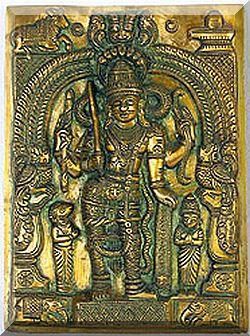
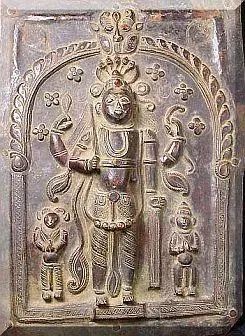
20.5. Sritattvanidhi,an amazing iconographic treatise of the 19th century commissioned by the then Maharaja of Mysore Sri Krisharaja Wodeyar III (1794 – 1868) mentions that Virabhadra-murti should have four arms, three eyes, terrifying face with fierce side tusks.He should hold in his right hands a broadsword (khadga) and an arrow (bana); and in his left a bow (dhanus) and a mace (gadha).He should be adorned with garlands of skulls, costumes of a warrior and thick footwear. On to the left of Virabhadra a figure of Bhadra Kali should be depicted. And, on his right a figure of Daksha with a goat-head with horns should be standing with folded hands (anjali –mudra).
20.6. Virabhadra is also depicted with ten arms ; three of the five arms on the right holding an arrow (bana), axe (parashu) and sword (khadga) .In his hands on the left he holds a mace (musala), a bow (dhanus),a lasso (pasha) , a shield (khetaka) and another long sword.The Shilparatna describes him as having eight hands and riding on vetala (a demon) surrounded by his ganas (nija gana sahita).His complexion is white and is fearsome. His disheveled hair is flying like wild fire; and he is clad in tiger skin. He stamps on Daksha symbolizing suppression of dogma and ignorance.


Dhyana-Shloka of Virabhadra
21. In the Dhyana shlokas of Virabhadra is virtually the Shiva. He is described as having white complexion, holding a mriga (deer), veena etc and adorned with snakes.
Following are some of such Dhyana slokas.
21.1. Svethangam Sesha Bhushangam Khadga Veena dharam Subham /
Drutakrishnamrigam veeram Shaardhoolajidhavasam //
Arthonmeelita Netram dham Trinetramcha Jadataram /
Suganthi Pushpamalam Sri Veerabhadram Namamyaham //
I worship the White complexioned Virabhadra, with half closed eyes along with the third eye in his forehead, his matted hair locked as Jatamakuta. He is adorned with snake- ornaments, tiger skin and garlands of fragrant flowers; holding an antelope.
21.2. Shannetram Trimugam Bheemam Kalamegha Samaprabham /
Udharsijvalanam Neelaghatram Shatbhahu Shobinam //
Banapatrasi Soolekshu Chapa Khadga dharam Subham /
Bhoothapretadhi Dhamanm dushtarati vinasanam /
Meru vasam Mahesam tam Veerabhadram Namamyaham //
I worship the Black complexioned Virabhadra in a Fierce form with three faces, six eyes, his hair-locks flaming as fire. His six arms hold Banapatra (arrow-case), sword, trishula, bow, arrow; and he blesses all who worship him. He tames and controls Bhutas and Pretas (demons and goblins), and destroys the evil and dwells forever in the Hill of Meru.
21.3 Chaturbhujam trinetram cha Jatamakuta manditham /
Saravabharana samyuktham swethavarnam vrushadvjam //
Soolam cha abhaya Hastham cha dakshinedhu karatvayam
Gadha varadha hastham cha Vama parshvey karathvayam //
Swetha Padmasanasoonam Vatavriksha Samasritam /
Veerabhadram Ithikyadam Brahmi roopam dhadha shrnu //
(Dhyana-Shloka in Amsumadbeda-agama)
I worship the White complexioned Lord Virabhadra with four arms, three eyes, Jatamakutam, adorned with ornaments , sporting a flag carrying a nandi image .In his right he holds Trisula and gestures Abhaya mudra ; and in his left he has a gadha and gestures Varadha mudra. He is sitting under the vata Tree, on a White Lotus seat…
21.4. Marakata Manineelam Kinginee Jalamaalam /
Prakasita Mugameesam Bhanu Soma-Aagni Netram ://
Hariharamasikedatraya Kradhandakra Hastham /
Vidhudharam ahi Bhusham Veerbhadram Namami : //
I worship Lord Veerabhadra, of Blue-Black complexion, in a fierce looking form of Shiva with the Sun, Moon and Agni as three eyes representing the Vibhuti of both Shiva and Vishnu, wearing the crescent Moon in his hair , Serpent garlands , ornaments of bells, and holding the sword, shield and club.
21.5. Akasha-Virabhadra Mantra :-
Kalarudra Rushihi /Jagadhee Chandaha /Veerabhadra Devata / Vam Beejam / Hoom Shakthihi /
21.6. Mula Mantra:
O Namo Veerabhadraya Vairi Vamsha Nivinasaya Sarvaloka Bayankaraya Beema Veshaya Hoom Phat Vijaya Vijaya Hreem Hoom Phat Svaha ׀

I bow down to Lord Virabhadra who is as fierce as Yama at the end of Kalpa
and whose terrible laughter causes the worlds to tremble,
for destroying my fears in crossing the terrible ocean of sorrows
— Amogha Sadashiva kavacha
References and sources
The original Daksha saga by Klaus Klostermaier
The Presence of Siva By Stella Kramrisch
Genealogy of the South-Indian gods: a manual of the mythology and religion … By Bartholomaeus Ziegenbalg,
The Horse-sacrifice of the Prajapati Daksha Kisari Mohan Ganguli Book 12: Santi Parva: Mokshadharma Parva: Section CCLXXXIV.The Mahabharata translated by
The Anatomy of Devotion: The Life and Poetry of Karaikkal Ammaiyar
Professor Elaine Craddock; Department of Religion and PhilosophySouthwestern University, TX
http://chinthamani-griha.blogspot.com/2007/01/veera-bhadra-murthy.html
All images are from internet
sreenivasaraos
March 18, 2015 at 7:58 am
I never knew the symbolic Representation of Dakota and Siva..
the yagna itself was a transition point of sorts
from the tradition of vedic rituals is what I have understood.
virabadra represents kriya shakhti is news to me.
the vayu purana version is very dignifying and less terrifying version compared to theirs.
where does the dog figure in the icono graphy.
any other relations with rudra kali.?
I am totally in tune with the following paragraph
“Our ancients always asserted that the immediate experience ( sakshat aparoksha) which liberates is truly superior to the intellectual knowledge of scriptures, rites and rituals. They explained it as the sort of experience that leads to the true understanding of the problems of being and becoming; that which aids to cross over all sorrows (shokasya param trayathi); and to realize one’s true identity. It is beyond the understanding of the intellect; it is experience (we shall return to this theme a little later).”
can you please give references for this and dwell more..
by referring to vayu purana you have put me in great ease..
I pray to almighty that he grants you all your wishes for
helping me in my jorney of life.. yes… your writing was of immense help.
DSampath
sreenivasaraos
March 18, 2015 at 8:00 am
Dear Shri Sampath, I am glad you read and found it useful despite its limitations. The Daksha- Shiva equation I mentioned is one of looking at the conflict. There others, including a bizarre one by the Theosophists.Please check here.
(i) Shiva harbored certain discontent or potent anger; he would not talk or even think about it .Devi draws out that suppressed anger and turns it into a strong wish. Virabhadra is the wish turned into action; he is the power of action (kriya shakhti).
(ii) The dog has a long history in Indian texts. In Rig Veda dog was seen as a reliable scout or a protector. Indra sends the mother of dogs Sarama, in search of cows that went missing. Dogs also stood for the valor of the warriors. Later, the dog was seen as the guard that protects by invoking fear in the hearts of strangers and intruders. It therefore became a companion of Bhairava as kshetra-pala one who protects the regions under his charge.
The dog also came to represent the end of one’s time (kaala) the death; and therefore companion of Yama. It is explained; the dogs look fierce, but they are in fact not to be feared as they are friendly creatures. He who realizes this reality overcomes the fear of dog (the death).
Bhairava whose companion is the dog helps us overcome the primal fear of death (see Ammaiyar).
The notion of the dog being man’s best friend and letting it into living room, bedroom, study and kitchen etc is rather comparatively recent in the Indian domestic context.
Earlier, dog was basically a creature of the street, of wilderness and of the cremation grounds; and meant to drive away strangers and intruders as also to guard the funeral pyres. Dog was associated with guards at the grave yards, drifters, mendicants and Avadhutas who had neither a home nor a family.
The dog represented the nature of its master and his homelessness or his detachment. Avadhuta Dattatreya is accompanied by four dogs said to be four Vedas. That puts in context the sublime nature of the Avadhuta and the scriptural learning which by itself is purposeless unless it is directed by one ‘who knows intuitionally’ -vijijnasasva.
(iii) As regards the last observation; Upanishads make a distinction between Para-vidya the higher knowledge and apara-vidya the lower knowledge (Munduka Upanishad :1.4).All scriptural knowledge including Vedas are regarded lower knowledge; and are not the real knowledge which enables one to know oneself and to cross over sea of sorrows (shokasya param trayathi- Chandogya Upanishad :7.1.3. )
Now, whatever is apprehended by senses is direct knowledge (pratyaksha) ; and what is inferred by intellect ,inference, memory, imagination, reasoning etc is indirect knowledge (paroksha) .It is said ; Atma-vidya the knowledge of self is beyond the reach of either direct or indirect knowledge. Kena Upanishad employs a peculiar term to describe self-knowledge Sakshat aparoksha – ‘immediate and non-indirect’.
The knowledge here, does not involve agencies like senses or intellect, as also the limitations associated with those agencies. It is therefore neither direct nor indirect; but it is immediate (sakshat) where there is no subject-object relation. And, it is non-indirect (aparoksha) because knowledge here has no recognizable form that one can learn or know.
It is explained; it is called Atma-vidya or jnana or knowledge merely for want of a term to denote the absence of subject-object relation.The expression jnana is therefore more suggestive than denotative.
It is said that the ancient sage Upavarsha stated that consciousness of the self (atma pratyaya) is one’s own intuition personal experience (aham pratyaya gamyatvat).it is not a matter of reasoning; it is immediate, absolute experience (param pratyaksham). It is content-less intuitional understanding and experience;self-luminous consciousness (sva praksha).
I mentioned about the problems of being and becoming because the Upanishads wonder how non-being (a-sat) turns into being (sat) and transforms into becoming. It is explained; a-sat, non- being does not denote non-existence but is meant to suggest the foundation (adhistana) of being (sat).
The problem appeared to be how to understand the Being through the layers of Becoming. They asserted what was required for the purpose was not mere explanations that describe but the true knowledge or experience that liberates or reveals (darshana).
I admire your patience wading through all this .Warm Regards
sreenivasaraos
March 18, 2015 at 8:03 am
In the earlier days you would be venerated as a sage.
what you say will be seen to come form the divine being itself.
but these are times when sages have to hide behind the garbs of
professionals and bloggers.
when I look at you like that each and every word that you utter matter to me.
So it is a gift from you to me..
It is people like you who bring magic back to my life..So where is the question of patience.It is your grace that I experience..
DSampath
sreenivasaraos
March 18, 2015 at 8:03 am
Shree Rao
I don’t know how I missed this. Read it in detail. Wonderful information as usual.
The Karaikkal Ammaiyar paragraphs are meticulously done.
Your answer / explanation – to Sampath ( and ofcourse all of us) is very much appreciated.
I found that all the Nagaraththaar Temples had Bhairava in a separate Sannidhi and Veerabhadra too. I have a picture of Veerabhadra which I clicked in a coule of temples but they have not come out well. Let me see if I can post it here for you.
Usha
sreenivasaraos
March 18, 2015 at 8:04 am
Dear Usha-tayi. I am glad you read the post on Sri Virabhadra and found it interesting.
I am delighted you saw also the comments by Shri DSamapth and my response. There were some interesting issues there.
The Life, poetry and philosophy of Karaikal Ammaiyar is most fascinating. I wish someone familiar with classical Tamil writes a detailed article on her.
Thank you for sending me the photo of the ten-armed Sri Virabhadra at the Aathangudi Temple. I have since included that in the Blog, placing it after the Dhyana Slokas.
Warm Regards